




Your support is critical to our success.
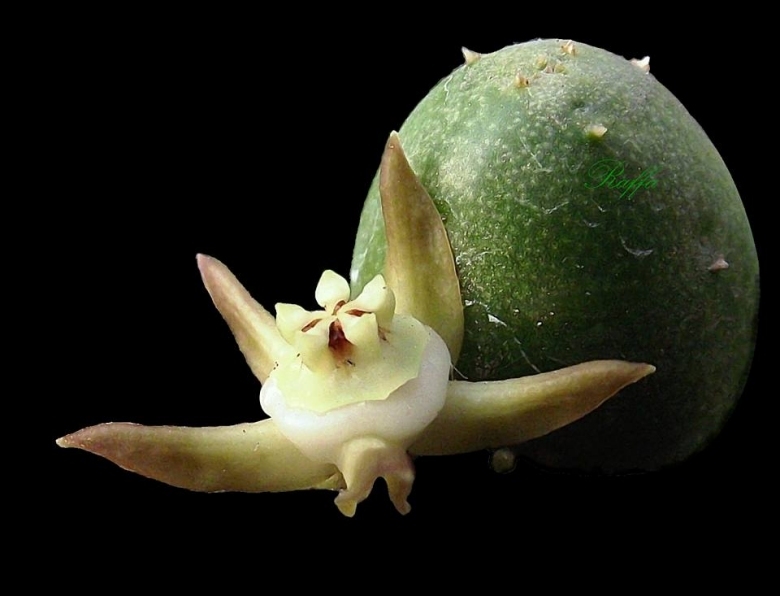
Origin and Habitat: Van Wyksdorp to Ladismith and Oudtshoorn, Western Cape (Little Karoo), South African. Extent of occurrence 1400 km², suspected to occur at 10 locations.
Altitude range: 300-600 metres above sea level.
Habitat and Ecology: Fynbos, Succulent Karoo. Duvalia parvifloraSN|30349]]SN|30349]] grows on flat, stony to loamy ground, under small karroid bushes, ongoing decline in habitat is currently taking place as a result of ostrich farming and to a lesser extent habitat is being lost for vineyard cultivation.
Synonyms:
- Duvalia parviflora N.E.Br.
Description: Duvalia parvifloraSN|30349]]SN|30349]] is a miniature perennial-succulent which produces an abundance of minuscule 'colourpoint' flowers, cream with lobe tips brownish-purple, lobes furrowed along their length. The species seems to be isolated from the rest in this genus.
Stems: Globose to oblong, about 10-25 mm long and 10-15 mm thick, very obtusely and somewhat obscurely 5(–6?)-angled, light green to greyish-green, mottled with dull purple, faintly glaucous, angles, with minute leaf rudiments less than 1 mm long, rather obscurely indented above each minute tooth, or obscurely and distantly tessellate-tuberculate.
Flowers: 2-6 together, near the stem base, successively developed near the apex of the stems, essentially scentless. Pedicels 3-8 mm long. Sepals 0,75-1 mm long, ovate-lanceolate, acuminate. Corolla about 10-15 mm in diameter, cream. pale yellow to yellowish-olive, with the apical half of the lobes tinged brownish or pale purple. Lobes 3-6 mm long, l 5 - 2 mm wide, very spreading, lamina convex, not completely reflexcd, closely replicate to the base into longitudinal furrows plates 1.5 mm deep, glabrous, ciliate with a few very minute simple cream-coloured hairs at the base only. Annulus 3-5 mm in diam., raised about 0,5-2 mm above the level of the lobes, slender. rounded or obtusely pentagonal, glabrous, the top quite covered (without leaving a margin) by the equally large outer corona; “outer and inner coronas straw-coloured, anthers purple”, disc 3.5-4 mm in diameter to 1 mm high more or less pentagonal. Convex, rising above the annulus. Pollinia 0.3 x 0.2 mm.
Fruits: Seed pods (follicles), usually appearing as twin horns up to a year after flowering, 8- 12 cm, fusiform, terete, apically acute, but not beaked, wingless, smooth, decorative.
Seeds: 3.5 x 2.5 mm.
Bibliography: Major references and further lectures:
1) N. E. Brown. “Flora Capensis”, Vol 4, page 518, 1909
2) Bruyns, P.V. 2005. “Stapeliads of southern Africa and Madagascar.” (Vol. 1, pp. 1-330). Umdaus Press, Pretoria.
3) Helme, N.A. & Raimondo, D. 2007. Duvalia parviflora N.E.Br. National Assessment: Red List of South African Plants version 2014.1. Accessed on 2015/01/25
4) Doreen Court “Succulent Flora of Southern Africa” CRC Press, 01 June 2000
5) Focke Albers, Ulrich Meve “Illustrated Handbook of Succulent Plants: Asclepiadaceae: Asclepiadaceae” Volume 4 Springer, 2002
6) Ulrich Meve, Focke Albers “The species concept in Duvalia (Asclepiadaceae): A preliminary revision of the genus” In: Mitteilungen aus dem Institut für Allgemeine Botanik in Hamburg. 1990.
7) Werner Rauh “The Wonderful World of Succulents: Cultivation and Description of Selected Succulent Plants Other Than Cacti” Smithsonian Institution Press, 1984
8) Bruyns, P. V. 2005. "Stapeliads of Southern Africa and Madagascar", vol. 1: 68-81.
9) Meve, U. 1997. "The genus Duvalia (Stapelieae)", 130 pp, Springer, Wien.
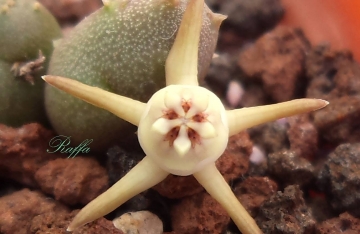
Duvalia parviflora Photo by: Raffa C. Garcia
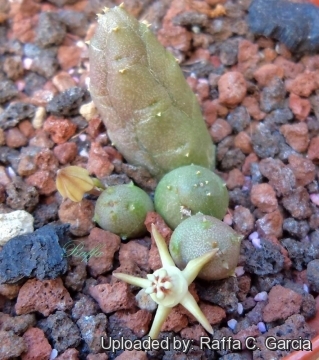
Duvalia parviflora Photo by: Raffa C. Garcia
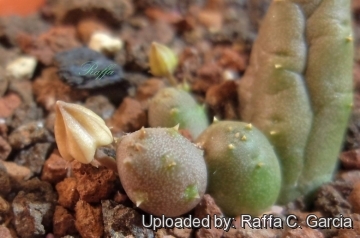
Duvalia parviflora Photo by: Raffa C. Garcia
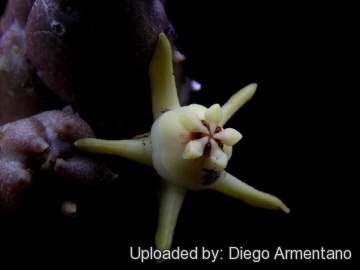
Duvalia parviflora Photo by: Diego Armentano
Cultivation and Propagation: Duvalia parviflora is an easy obliging blooming plant when mature, that it is happy in any average succulent house.
Potting:Since roots are quite shallow, use a soft and incoherent cactus mix or add extra perlite or pumice to regular soil potting soil, and clay pots help the plants to dry out between watering.
Waterings: Duvalia require moderately watering through the growing season but enjoy plenty of water and some fertiliser in hot weather, this helps them to flower freely. Water more sparingly in winter according to temperatures. But, as with most asclepiads, it is unwise to leave them wet in cold weather.
Fertilization: Fertilizers for succulent plants must be rich in potassium, but poor in nitrogen, to avoid the plants from developing excess vegetation, which is easily attacked by fungal diseases.
Sun Exposure: As with many succulents, they prefer to grow in the light shade of scrubby shrubs or between rocks where they get some shade during the day. In summer it is advisable to position this plant in a partially shady place, where it is exposed to direct sunlight only during the coolest hours of the day.
Hardiness: These plants don't like cold weather, therefore in the Spring it is best to set them outside only when the temperatures are above 15°C. Can endure temperatures below 5°C for short period, but only if the soil stays completely dry.
Pest and diseases: Duvalia species vary in their susceptibility to rotting, but are generally fairly easy to grow, especially if kept pest-free. They are very susceptible to stem and root mealy bugs, and damage from these may well initiate fungal attack. If you do have problems with a stem or with basal rotting, you can reliably isolate the healthy parts, dry them off, and re-root them in moist compost.
Cultural Practices: Re-pot every 2 years.
Propagation: Easiest with stem cuttings. Allow cuttings to dry a day before planting. Stems must be laid (Not buried) on gritty compost and will then root from the underside of the stems. It can also be increased from seeds sowing in spring in moist, sandy peat moss. Barely cover seeds. Seeds germinate quickly.
| Your Actions | |
|---|---|
| Back to Duvalia index | |
| Back to Asclepiadaceae index | |
 |
Back to Succulents Encyclopedia index |
Privacy stantement - Terms and conditions - How to cite - About us - Feedback - Donate




